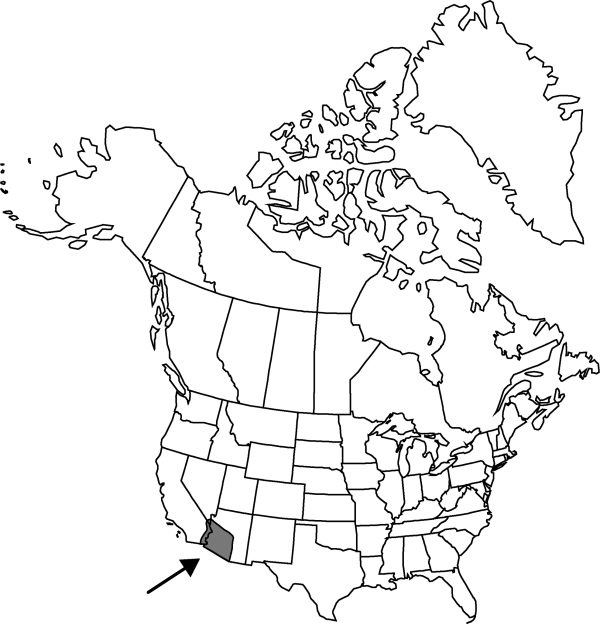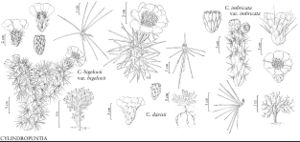Cylindropuntia bigelovii var. bigelovii
Trees, densely branched, with older branches at base of crown dark-brown, clinging to usually solitary trunk, 0.3–1.5 (–3) m. Stem segments whorled or subwhorled, green to gray-green, 4–13 (–18) × (2–) 4–5.5 cm, distal ones usually very easily detached (propagules); tubercles salient, broadly oval, 0.4–0.8 cm; areoles elliptic-deltate, 5–6 ×3–4 mm; wool white-yellow to brownish, aging gray. Spines (8–) 10–15 per areole, at most areoles, interlaced with spines of adjacent areoles, usually uniformly, diffusely spreading and nearly completely obscuring stem, pale-yellow to yellow to tan, aging brown; abaxial spines spreading to deflexed, subterete to flattened, the longest (10–) 15–25 mm; adaxial spines erect or spreading, terete, the longest (10–) 20–28 mm; sheaths uniformly whitish or pale-yellow, not obviously baggy. Glochids in broad adaxial crescent, sometimes extending along areole margins, yellow, 3–4 mm. Flowers: inner tepals pale green to whitish, sometimes tipped red, spatulate, (15–) 20–25 mm, emarginate-apiculate, often erose; filaments green; anthers orange; style light green; stigma lobes light to dark green. Fruits usually sterile, not proliferating, yellow at maturity, cylindric to broadly obconic, (15–) 22–40 × (8–) 16–20 (–28) mm, fleshy-leathery, strongly tuberculate, becoming spineless, losing bristlelike spines of young fruit; umbilicus 8–10 mm deep; areoles 36–64, evenly spaced. Seeds, when present, pale-yellow, in gelatinous mass, angular to squarish in outline, 2.5–4 × 2.2–3.5 mm, warped, sides with 1–2 large depressions; girdle smooth or as very narrow marginal ridge. 2n = 22 or, usually, 33.
Phenology: Flowering spring–fall (Mar–Jun, Sep).
Habitat: Mojave and Sonoran deserts, sandy flats, gravelly to rocky washes, bajadas, hillsides
Elevation: 300-900 m
Distribution

Ariz., Calif., Nev., Mexico (Baja California Sur), Mexico (Sonora)
Discussion
Cylindropuntia bigelovii forms two hybrids. Cylindropuntia ×fosbergii (C. B. Wolf) Rebman, M. A. Baker & Pinkava (= C. bigelovii × C. echinocarpa), which L. D. Benson (1982) treated as Opuntia bigelovii var. hoffmannii Fosberg, occurs southwest of the Salton Sea, California, forms shrubby trees 1–2 m with yellow-green inner tepals and green filaments, and has a chromosome number of 2n = 33. Cylindropuntia ×campii (M. A. Baker & Pinkava) M. A. Baker & Pinkava (= C. bigelovii × C. acanthocarpa) forms more open trees than O. bigelovii, has yellow-green inner tepals and filaments, and has a chromosome number of 2n = 44.
Selected References
None.
